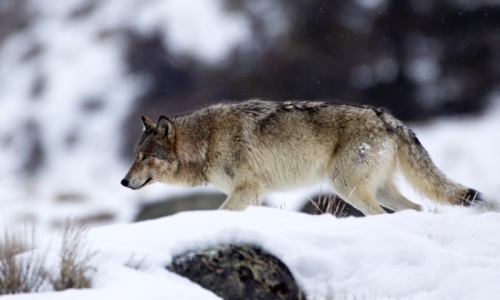This blog post is
written in response to Tasmin’s comment on the last post, in which she states “I recently heard that cats originated in the Americas and moved onto the
European continent at the same time canines moved from the European continent
to America (a sort of switch over) Have you heard anything about this?” After
reading through several articles, I was not able to find evidence that supports
this idea of a“crossing over” of dogs
and cats between the European and American continents.
 |
| Figure 1: Canis lupus |
According
to the paper “From Wild Animals to Domestic Pets, an Evolutionary View of Domestication,”
Driscoll et. al state that domesticated dogs are believed to have descended
from grey wolves, Canis lupus, in
Eastern Europe. They are considered to be the first organism, including animals
and plants, to be domesticated by humans. 14,000 years ago, in a time when
humans were nomadic hunters and gatherers, members of Canis lupus began to follow human hunting groups in hopes of eating
leftover scraps or catching prey wounded by humans. Their behavior began to
shift in a way that benefited both them and humans. They would assist each
other in chasing and tracking prey and sound alerts by barking at the approach
of predators. For these reasons, humans allowed wolves to follow them and
eventually started rewarding them with food for their help in hunting.
Eventually, humans began selecting their favorite wolf puppies to personally
raise and train. These puppies were often social and friendly towards humans.
Humans began to mate their selected wolfs with one anther, unintentionally
practicing artificial selection and creating a whole new species, the
domesticated dog. Dogs were spread all over the world with the movement of
nomadic peoples. (Driscol et. al, 2009, B).
So, domesticated dogs do originate from Europe and eventually made their
way to the Americas. Cats, however, do no originate from the Americas.
After
several searches, I could not find any articles stating that cats, domesticated
or wild, originate from the Americas. Most articles are in agreement that
domesticated cats originated from the wildcat species F.S lybica in the Middle East. Cats were drawn towards human
settlements by the mice and other small prey attracted to the settlements. Cats
were allowed into human homes because they acted as pest control. Cats, unlike
dogs, largely evolved into the species we see today through natural selection
(Driscoll et. al, 2009, A, Driscoll et. al, 2009, B, Lipinski et. al, 2008, and
O’Brien et. al, 2001).
 |
| Figure 2: F.S lybica |
The
oldest member of the cat family at 7 million years old is pseudaelurus , and is
believed to have originated in Europe. Cats did not reach the Americas until
the formation of the Barren Straight 2.9 million years ago. While some cats,
such as the American Cheetah, did move out of the Americas and back into Africa
and Asia, this is not believed to be the case with F.S lybica, who is believed to have broken off from European cats
(O’Brien et. al, 2001).
Based
on this evidence, the theory of dogs and cats crossing over between the
European and American continents is incorrect, as cats originate from the
Middle East, not the Americas. Dogs were also domesticated much earlier, at 14
million years ago (Driscoll et. al, 2009, B), than cats at 3.4 million years
ago (O’Brien et. al, 2001). Any articles that support the idea stated in Tasmin’s
comment would be greatly appreciated and accepted with great interest.
Works Cited:
Driscoll, C, Clutton-Brock, J,
Kitchener, A, and O’Brien, S, 2009, “The Taming of the Cat,” Scientific American. Vol 300, pg. 68-75.
(Cited Driscoll et. al A)
Driscoll, C, Macdonald, M, and O’Brien,
S, 2009, “From Wild Animals to Domesticated Pets, an Evolutionary View of
Domestication, PNAS, Vol 106, Is I,
pg. 9971-9978 (Cited Driscoll et. al B)
Lipinksi, M, Froenicke, L, Baysac, K,
Billings, N, Leutenegger, C, Levy, A, Longer, M, Niini, T, Ozpinar, H, Slater,
M, Pedersen, N, and Lyons, L, 2008, “The Ascent of Cat Breeds: Genetic
Evaluations of Breeds and Worldwide Random-bred Populations,” Genomics, Vol 91, Is. 1, pp 12-21.
O’Brien,
S, and Johnson, W, 2001, “The Evolution of Cats, “Scientific American, Vol 297, pg. 68-75,
Figure 1: From http://www.yellowstoneparknet.com/wildlife/wolves.php. Retrieved 5/4/15
Figure 2: Fromhttp://www.namibian.org/travel/wildlife/african_wild_cat.html. Retrieved 5/14/15
Thanks for that. It wasn’t my idea … just something I’d heard and wondered about the validity of it. The origin of cats appeared to be the questionable part in that idea so thanks for the clarification.
ReplyDelete